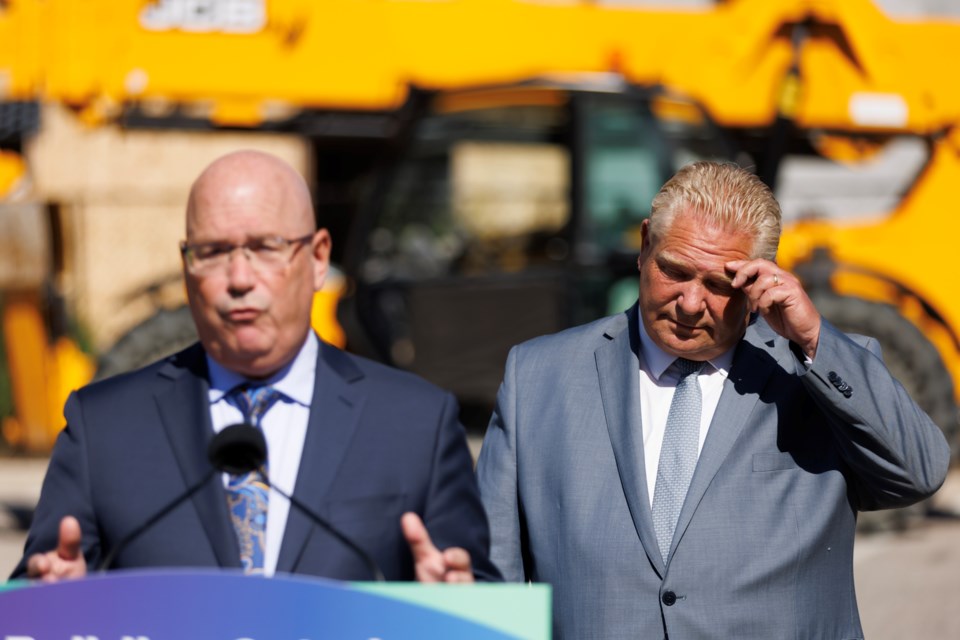No ‘preferential treatment’ in Greenbelt decisions, Ford insists

Ontario Premier Doug Ford listens as Ontario’s minister of housing Steve Clark speaks during a press conference in Mississauga, Ont., Friday, Aug. 11, 2023. |
From BarrieToday, August 11, 2023
By Aidan Chamandy
EDITOR’S NOTE: This article originally appeared on The Trillium, a new Village Media website devoted exclusively to covering provincial politics at Queen’s Park.
Premier Doug Ford insisted his government didn’t give any developers a leg up when deciding which land to remove from the Greenbelt, despite auditor general Bonnie Lysyk’s report saying the opposite.
“No one had preferential treatment,” Ford said on Friday, during an unrelated announcement for 40 new supportive housing units in Mississauga.
Lysyk’s bombshell report explicitly said the Tories gave “preferential treatment” to developers with “direct access” to Ryan Amato, Housing and Municipal Affairs Minister Steve Clark’s chief of staff, who had “substantial control” over the process.
Ontario’s integrity commissioner is reviewing whether to look into Amato’s conduct.
Last year, Amato was tasked with figuring out which lands to remove. He heavily relied on input from developers, Lysyk found.
Nearly 7,400 acres were ultimately taken out from 15 different parcels of land.
About 92 per cent of the land was from five sites proposed to Amato by two prominent developers who sat with him at an industry association dinner on Sept. 14, 2022.
Two of the sites taken out were given to him by the two developers “in packages” at the September dinner hosted by the Building and Land Development Association. These lands — owned by TACC Developments and Green Lane Bathurst LP — accounted for about two-thirds of the land that was later removed.
The principals of TACC have been generous donors to Ford and the Tories, as well as other political causes. A name matching the developer behind Green Lane Bathurst LP also has a generous record of donations that includes Ford’s leadership campaign and the PCs.
The day after the dinner, Sept. 15, Green Lane Bathurst LP finalized purchasing the land it wanted out for $80 million.
The day after that, on Sept. 16, is when Amato first told the housing department he wanted to move ahead with the removal process on a site-specific basis, rather than by evaluating the Greenbelt as a whole.
Shortly after the dinner, one of the same developers proposed three more sites — two owned by TACC and one by Fieldgate Homes — that were also later removed from the Greenbelt.
The Tories initially said the public service was responsible for suggesting sites for removal, but Amato actually dictated the criteria and proposed the vast majority of sites.
He gave these criteria to the public service in early October, but later altered them so sites he wanted would be included. This included axing criteria that the lands were easily serviceable with roads, sewage and utilities, and more.
Another developer who benefited from the land swap — Flato’s Shakir Rehmatullah — attended the premier’s daughter’s wedding on Sept. 25, 2022.
Two days after the wedding, lawyers representing Rehmatullah’s emailed Amato asking for the removal of three parcels in York Region. The lands were later taken out of the Greenbelt.
On Wednesday, Ford was asked how the lawyers knew to contact Amato.
“Well, no one, no one knew. No conversation ever, ever was discussed, I can guarantee you that,” he said. “I found out the day of when we went to cabinet, which happens frequently, happens all the time.”
Both Ford and Clark said they didn’t know what Amato was up to, even though Lysyk said Clark “ought” to have known.
Ford and Clark also hinted that the government’s 1.5 million homes by 2031 target — drawn from the task force report — might not be nearly enough to fix Ontario’s housing woes.
For months, the two have said the Greenbelt land is needed to meet the goal despite numerous reports singing a different tune.
Times have changed, Clark and Ford said, since they set the target. Rapid population growth and new federal immigration targets mean more housing needs to be built.
“I don’t think 1.5 million is going to be enough. I think we’re going to need probably 1.8 million. Either way, we’re going to continue building homes,” Ford said.
TD, National Bank, and the Canada Mortgage and Housing Corporation (CMHC) have all come out with reports since the task force arguing for more homes.
The CMHC report looked at how many units Ontario needs to restore affordability to early-2000s levels, when residents dedicated about 40 per cent of their disposable income to buying an average new home in the province.
It estimated the province needs to build about 1.8 million units above the 750,000 already projected, for a grand total of roughly 2.5 million homes in less than 10 years.
-With files from Jessica Smith Cross and Charlie Pinkerton
Read the article here









Leave a Reply